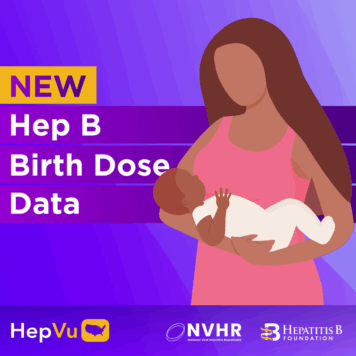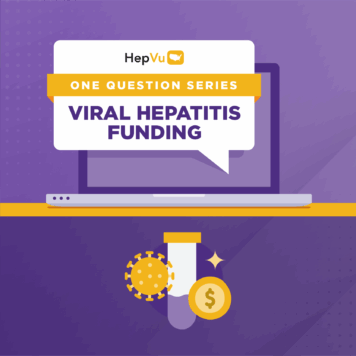Dr. John W. Ward is the Director of the Coalition for Global Hepatitis Elimination. Previously, he served as the Director of the Division of Viral Hepatitis at the Centers for Disease Control and Prevention (CDC).
Q: You were Director of the CDC’s Division of Viral Hepatitis (DVH) for 13 years. How did you first get involved in this field and how has it changed in recent years?
I became interested in hepatitis, specifically Hepatitis B, as a medical resident. In the early 1980s, the vaccine for Hepatitis B became available and I began to look at vaccination rates and why they were different among various demographics. This led me to discover the Epidemic Intelligence Service (EIS) program within CDC; I applied and joined CDC with the intent of supporting the viral hepatitis program. I was drawn to this because, in addition to my interest in vaccination, my home county, Alabama’s Jefferson county, was one of the four sentinel initial surveillance sites for viral hepatitis.
When I arrived as an EIS officer in 1984, a doctor at CDC named Jim Curran, a key figure in the early fight against AIDS (and Advisory Committee Chair for AIDSVu and HepVu), said “He who knows AIDS, will know medicine.” A light bulb went off in my head and I ended up being selected as the third EIS officer for the AIDS program and stayed there for 14 years. I am very grateful that I acted on my original intent of coming to CDC, contributing to the AIDS response later editing as editor of the MMWR. These experiences prepared becoming director of the DVH at CDC.
Over those 13 years, there has been substantial progress in the study and treatment of viral hepatitis. We changed policies to improve Hepatitis B vaccination coverage among newborns, and Hepatitis A vaccination among children. The virus that causes Hepatitis C was discovered in 1989, leading to the first test in 1992. Since that time, blood bank screening and other prevention measures decreased transmission. Persons who inject drugs remained at the highest risk for Hepatitis C. Since the early 1990s, mortality from Hepatitis C has increased. By 2005, researchers were becoming convinced curative anti-viral therapies could be developed for Hepatitis C. Fortunately, in 2014, this research was successful resulting in the licensure of the first all-oral treatments for Hepatitis C. A cure of hepatitis C lowers mortality risks by 80%. An amazing discovery in the history of medicine. This greatly increased the importance of testing and linkage to care. Hepatitis C is a silent but deadly infection. Most persons are unaware of their status. To target testing to reach 80% of persons living with Hepatitis C in the US, we developed the CDC recommendation for a one-time HCV test for all persons born during 1945-1965, baby boomers. This recommendation was adopted by the US Preventive Services Task Force. With the availability of effective vaccines, reliable tests, and curative therapies for Hepatitis C, our strategies shifted from hepatitis control to hepatitis elimination.
Q: Can you tell us more about your work with The Coalition for Global Hepatitis Elimination and the strategies in place to help prevent viral hepatitis outbreaks and, ultimately, work towards eliminating Hepatitis B and C?
Working in partnership with the World Health Organization, we were able to make the case for elimination as a feasible public health goal, and successfully received the endorsement of the World Health Assembly and by the National Academy of Sciences here in the United States. I realized we needed expertise to assist this effort. I approached the Task Force for Global Health as an organization with great experience in managing disease elimination programs. Fortunately, CDC saw value in bringing the Task Force into the fight to eliminate hepatitis. So, as a result, in 2018, I transitioned, on assignment from CDC, to the Task Force. This month, I moved into a full-time position at the Task Force with an academic appointment in Hubert Department of Global Health, Rollins School of Public Health.
After arriving at the Task Force, I found that largest global health initiatives, particularly ones focused on disease elimination, have a coalition striving to bring stakeholders together to sharing experiences and lessons learned to help others feel more confident that what they’re doing will be effective. This resource was missing for hepatitis elimination. I proceeded to develop the Coalition for Global Hepatitis Elimination. Currently, the Coalition for Global Hepatitis Elimination has three key areas of work in support of global goals for hepatitis elimination.
- Link all partners working to eliminate hepatitis in a community of practice
- Provide quality information to guide program planning and implementation
- Contribute technical assistance as the Help Desk for hepatitis elimination:
Viral hepatitis is a global problem with 1.3 million deaths per year, most of those caused by Hepatitis B and C. Prevention measures include avoiding blood contact by screening the blood supply and having good infection control in health care.
CGHE is a global coalition of programs around the world including the United States. To some degree, I believe we sometimes have an artificial division between domestic and global programs. In my experience with hepatitis, there are successful programs across the world that we could benefit from and try to replicate in the U.S. So when I speak of a global coalition, I’m including all the partners in the U.S. that are committed to elimination. We want them to be part of this global community where we are all working together to eliminate hepatitis.
Q: As the previous chief of CDC’s AIDS Surveillance Program, why do you think it is important that we focus on the intersection between viral hepatitis, HIV, and other health disparities?
I think the increase in transmission of Hepatitis A, B, and C in the U.S. clearly correlates to social and behavioral factors. For example, recently we’ve seen a nearly three-fold increase in Hepatitis C virus transmission, which is very much associated with injection drug use. We began to observe increases in states like Massachusetts as far back as 2007, and incidents increased rapidly in the Appalachian states – which, frankly, was overwhelming for health systems to accommodate. We’ve seen smaller increases in Hepatitis B transmission, typically occurring in the same states that have higher rates of Hepatitis C.
During the past two years, there has been an explosion of Hepatitis A virus transmission, which differs from the bloodborne Hepatitis B and C viruses. Hepatitis A is a consequence of poor hygiene; more a result of hand-to-hand exposure with contaminated water, food, or someone who is infected. But at the same time, those populations are largely homeless communities in the US that have also reported high rates of co-infection with Hepatitis B and C as a result of injection drug use. Consequently, in some cities like San Diego, there have been high rates of mortality due to underlying liver disease with the addition of Hepatitis A.
I do believe that the outbreaks of hepatitis expose weaknesses in the social fabric and changes in the social factors in a region. For instance, if you consider an area that lacks the resources to support successful infection control, there will be higher rates of hepatitis. Socioeconomic factors such as decreasing employment opportunities or family disruption are also very prominent social determinants of health which increase the risks of behaviors that result in viral hepatitis.
Q: HepVu recently added three opioid indicator maps to its site. How does visualizing data help us better understand and respond to the infectious disease consequences of the opioid epidemic?
The data visualization tool that HepVu provides is helpful in several ways. In public health practice, the maps enable users to prioritize resources for investigation and prevention. Viewers can use the data to look at risk factors, like narcotic use, that can help confirm the major mode of transmission in a given area or anticipate epidemics elsewhere.
Further, HepVu’s maps can be used to inform policymakers as to where resources are most needed for surveillance and prevention. Lastly, I think the maps educate the public about the consequences of injection drug use related to the opioid epidemic. A more knowledgeable, more informed public leads to a greater understanding of what public health officials are trying to accomplish. Even in areas where the general public is not seeing these cases, people can understand how these factors are linked together. That will help the public be supportive and responsive if and when they become part of an intervention plan.
Q: Every year, HepVu and other Hepatitis organizations mark July 28 as World Hepatitis Day. How should people be thinking about Hepatitis on days like that, and throughout the year?
Number one, on the individual level, ask yourself, “Am I at risk for hepatitis?”. If so, please get vaccinated for protection and get tested so that you infected can start appropriate treatment. On a larger level, I would like everyone to recognize that we have a rare opportunity to eliminate hepatitis, a major cause of mortality across the globe. On World Hepatitis Day and throughout the year, I would call on everyone to join with the Coalition for Global Hepatitis Elimination and work together to eliminate hepatitis globally.
To learn more contact Dr. Ward at jward@taskforce.org.




